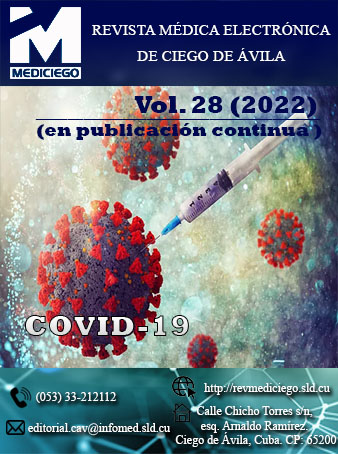Taphonomic effects on a hanged man. Case report
Keywords:
asphyxia , cadaver, completed suicide , paleontology, postmortem changesAbstract
Introduction: in the corpses that remain outdoors there is a confluence of taphonomic agents: necrophagous (insects, canid rodents, birds), abiotic (humidity, precipitation, temperature) and anthropic elements that could be related to the circumstances of death and body management. In the hanged, the very position of the corpse limits access to ghouls and the effect of the weight of the body itself generates postmortem changes very different from those of a body lying on the ground.
Objective: presentation of a case where taphonomic events caused different changes in the same corpse.
Presentation of the case: it is about the discovery of a corpse corresponding to a hanged subject, with parts of the body in skeletal reduction and others in corification, where the effect of the position of the body, the weather and the clothing, caused the action of the scavengers would be affected. All these taphonomic factors made it possible for the same corpse to show different postmortem changes, corification and skeletal reduction, elements that are not common in the natural environment.
Conclusions: the taphonomy in the hangings shows very particular characteristics that differ from the rest of the cases. The joint work of the forensic doctors made it possible to interpret the observed postmortem changes, to clarify their cause, as well as to corroborate the cause of death and basic elements for the identity of the corpseDownloads
References
Lloveras Ll, Rissech C, Rosado N. Tafonomía forense. En: Sanabria-Medina, C. (Ed.). Patología y antropología forense de la muerte: la investigación científico-judicial de la muerte y la tortura, desde las fosas clandestinas, hasta la audiencia pública [Internet]. Bogotá: Forensic Publisher; 2016 [citado 13 Sep 2020]:453-523. Disponible en: https://isbn.cloud/9789585970700/patologia-y-antropologia-forense-de-la-muerte/
Dirkmaat DC, Passalacqua NV. Introduction to Part VI. Forensic Taphonomy. En: Dirkmaat DC (Ed.). A Companion to Forensic Anthropology. Chichester, West Sussex: Wiley-Blackwell; 2013. p. 473-476.
Gifford-González DP. Bones are not enough: analogues, knowledge, and interpretive strategies in zooarchaeology. J Anthropol Archaeol [Internet]. 1991 [citado 13 Sep 2020];10(3):215-54. Disponible en: https://www.researchgate.net/profile/Diane-Gifford-Gonzalez/publication/222787534_Bones_are_not_enough_Analogues_knowledge_and_interpretive_strategies_in_zooarchaeology/links/5f25a616458515b729f96fc2/Bones-are-not-enough-Analogues-knowledge-and-interpretive-strategies-in-zooarchaeology.pdf
Lyman RL. Vertebrate Taphonomy. Cambridge: Cambridge University Press; 1994.
Kjorlien YP, Beattie OB, Peterson AE. Scavenging activity can produce predictable patterns in surface skeletal remains scattering: Observations and comments from two experiments. Forensic Sci Int [Internet]. 2009 [citado: 13 Sep 2020];188(1-3):103-6. Disponible en: https://prism.ucalgary.ca/handle/1880/106744
Moraitis K, Spiliopoulou C. Forensic implications of carnivore scavenging on human remains recovered from outdoor locations in Greece. J Forensic Legal Med [Internet]. 2010 [citado: 13 Sep 2020]; (17):298–303. Disponible en: https://www.sciencedirect.com/science/article/abs/pii/S1752928X10000600?via%3Dihub
O’Brien TG, Kuehner AC. Waxing grave about adipocere: Soft tissue change in an aquatic context. J Forensic Sci [Internet]. 2007 [citado 13 Sep 2020];52(2):294–301. Disponible en: https://onlinelibrary.wiley.com/doi/pdf/10.1111/j.1556-4029.2006.00362.x
Pokines JT. Faunal dispersal, reconcentration and gnawing damage to bone in terrestrial environments. En: Pokines JT, Symes SA (Eds.). Manual of Forensic Taphonomy. Boca Ratón: CRC Press; 2013: p. 201-248.
Published
How to Cite
Issue
Section
License
Copyright (c) 2023 Llesenia González Noyola

This work is licensed under a Creative Commons Attribution-NonCommercial 4.0 International License.
Those authors who have publications with this journal accept the following terms of the License CC Attribution-NonCommercial 4.0 International (CC BY-NC 4.0):
You are free to:
- Share — copy and redistribute the material in any medium or format for any purpose, even commercially.
- Adapt — remix, transform, and build upon the material for any purpose, even commercially.
The licensor cannot revoke these freedoms as long as you follow the license terms.
Under the following terms:
- Attribution — You must give appropriate credit , provide a link to the license, and indicate if changes were made . You may do so in any reasonable manner, but not in any way that suggests the licensor endorses you or your use
- No additional restrictions — You may not apply legal terms or technological measures that legally restrict others from doing anything the license permits.
The journal is not responsible for the opinions and concepts expressed in the works, which are the exclusive responsibility of the authors. The Editor, with the assistance of the Editorial Committee, reserves the right to suggest or request advisable or necessary modifications. Original scientific works are accepted for publication, as are the results of research of interest that have not been published or sent to another journal for the same purpose.
The mention of trademarks of specific equipment, instruments or materials is for identification purposes, and there is no promotional commitment in relation to them, neither by the authors nor by the editor.






















